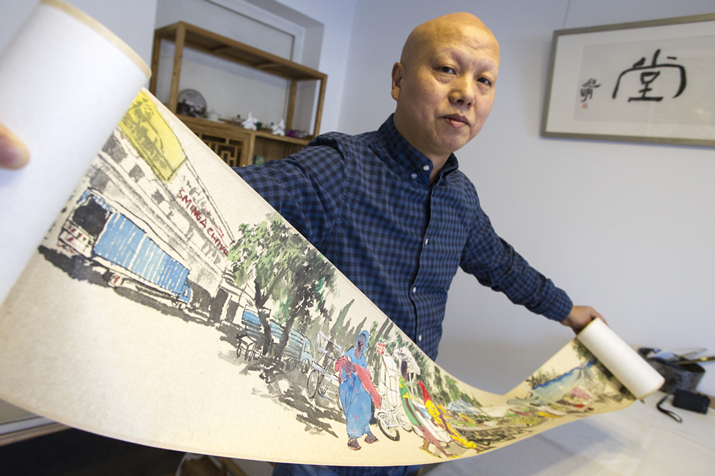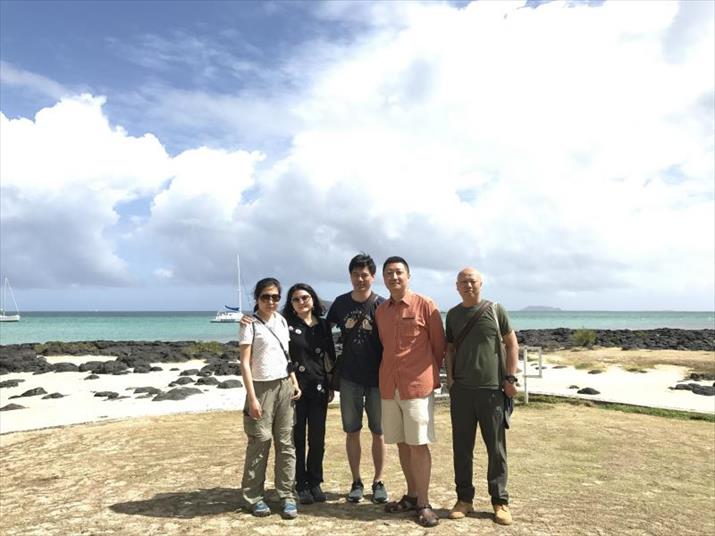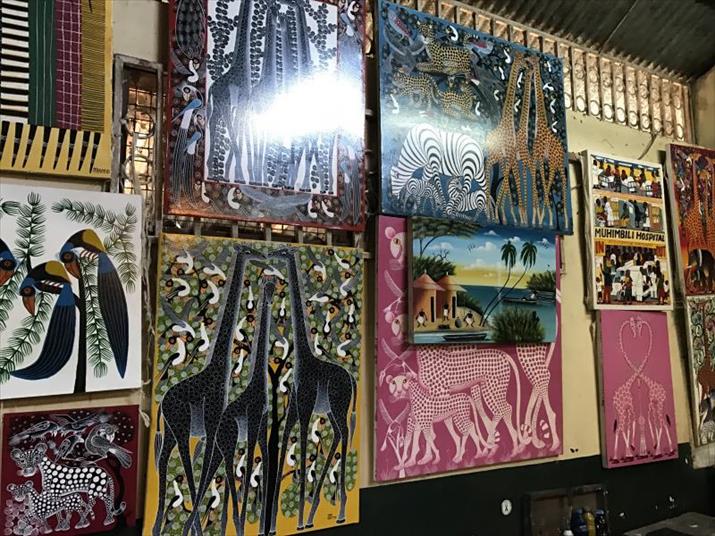|
||||||||||
| Home Nation World Business Opinion Lifestyle ChinAfrica Multimedia Columnists Documents Special Reports |
|
||||||||||
| Home Nation World Business Opinion Lifestyle ChinAfrica Multimedia Columnists Documents Special Reports |
| Lifestyle |
| The African Canvas |
| Chinese artists find the inspiration for new creations on a journey to the continent |
| By François Dubé and Cui Xiaoqin | VOL. 9 April 2017 ·2017-03-30 |

"As the plane began its descent, a piece of blue ocean in the middle of the African landmass appeared through the clouds: It was the enormous Lake Malawi, whose crystal-clear waters glistened under the sun's rays, surrounded by large expanses of lush green forests," said Wang, a 32-year-old woman who graduated from China Central Academy of Fine Arts in 2009 and has painted ever since.
At her side in the airplane were four fellow artists, invited by the Ministry of Culture of China on a trip to Africa. For 11 days from January 9 to 19, the group of five artists, two women and three men, visited three countries - Malawi, Tanzania and Mauritius, where they exchanged ideas with their African peers and tanked up on inspiration.
But as the plane was circling above Malawi, the thoughts of the nervous group were far removed from artistic influences and inspiring encounters awaiting them on the ground. A tense atmosphere prevailed in the small aircraft, recalled Wang, the group's youngest member, as it was the first visit to Africa for most of them.
This was the case for Fu Xuguang, 44, Professor at China Central Academy of Fine Arts and Tsinghua University's Academy of Arts and Designs.
He told ChinAfrica that when he first received the invite he had doubts as it seemed so distant and unlikely that this would happen to him. Despite his original misgivings, he took the plunge. But when the wheels of the plane finally touched the African soil after more than 20 hours of flight, reality hit home and he got cold feet. Would their first stop, Malawi, known as the "warm heart of Africa," give them a welcome as warm as its reputation suggested, wondered Fu.
Back in time
Organized and funded by the Network of International Culturalink Entities (NICE), an institution under China's Ministry of Culture, the purpose of this trip was to enable Chinese painters to have a personal experience of Africa, and then showcase it to their compatriots through their art.
The paintings, inspired and created as a result of this journey, will be exhibited in Mianyang City, Sichuan Province, on April 15, 2017, as part of the Belt and Road Scenery Exhibition, jointly organized by the Sichuan Institute of Culture and Arts and NICE.
This activity is part of the China-Africa people-to-people exchange plan, which was included in the Forum on China-Africa Cooperation (FOCAC) Johannesburg Action Plan 2016-18, aimed at increasing exchanges and mutual learning between the African continent and China. With this in mind, the artists began their journey.
Accompanied by members of the local Chinese medical mission in Malawi, they drove around the country, starting from Lake Malawi before heading for the Zomba Massif, a mountain of the Shire Highlands in south Malawi.

The five artists looking for inspiration in Mauritius
Already, the Chinese artists began to draw sketches and rough drawings that would later guide their work back in China. Seeing many bicycles and the simple life of locals, they found Malawi to stir up unexpected feelings of nostalgia for a bygone era.
Liu Kai, 48, Associate Professor at the School of Fine Arts of Shandong University of Arts, describes his experience in Malawi as "going back in time."
"Time seems different here. Changes in China since the late 1970s have been so great and time there goes by like bolts of lightning, while time in Malawi seemed slowed down," he told ChinAfrica.
Zhang Chun, 47, Vice Chairman of the Shandong Province Oil Painting Society, had similar feelings. "Malawi has given me the feeling of going back in time and in space. Seeing these old cities and towns, the layout of goods in old-school stores and so on, I felt I was going back in my past. However, returning to the capital, with its convention center, its huge hotels, its advertisements, was like returning to modernity. I love these conflicts and contradictions, and this will be reflected in my works," he told ChinAfrica.
As for Wang, it is the small details of life in Malawi that inspired her the most. "The traditional Malawi houses, made of earth and thatch, the rustic roofs and braided fences, those are things that you cannot find elsewhere," Wang said. "These things will not exist forever. Like China, Africa will develop and these small details of life will eventually disappear."
A vibrant culture
On January 12, the troupe set foot on the tarmac at Julius Nyerere International Airport, in Dar es Salaam, Tanzania. Under a scorching heat wave, they visited a village known for its art of tingatinga, a unique form of Tanzanian painting dating back to the 1960s, made by colorful enamel paint on stretched muslin and canvas and depicting animals and scenes from African life. The art form is a big hit with tourists.
Fu, a specialist in guohua, traditional Chinese painting, fell in love with the naive, childlike and direct style of tingatinga.

A tingatinga shop in Tanzania
"The tingatinga are shallow in depth, but their content is rich in typical African elements," he explained to ChinAfrica. "The strong point of African art is that it is undoubtedly the most ancient art form of humanity. It has preserved the primal aspect better than Chinese art, and this is its greatest charm. It expresses things directly and straightforwardly, without trying to describe them. This characteristic is similar to the traditional Chinese art of 'freehand painting,' and opens up possibilities for exchanges."
Although tingatinga is not a traditional African art form as such, since it appeared only recently, its style is impregnated and warm, creating a vibrant and attractive product, according to Wang. "This African style inspired Picasso, and also inflamed the creative passion of our group," she said.
The five artists are inspired not only by the creations, but also by the Tanzanian artists themselves, for whom creation is a matter of survival.
Chen Cheng, 38, painter and employee of NICE, explains: "The life of the tingatinga creators is not as colorful, humorous and relaxed as their paintings. These paintings are like them: they show a positive and optimistic attitude toward life, despite all the difficulties they might encounter. They strive to make beautiful colors and cheerful rhythm shine through the cracks of a hard and difficult life, and I think that is what impresses the public."
| 2Next |
| About Us | Contact Us | Advertise with Us | Subscribe |
| Copyright Beijing Review All rights reserved 京ICP备08005356号-5 京公网安备110102005860号 |